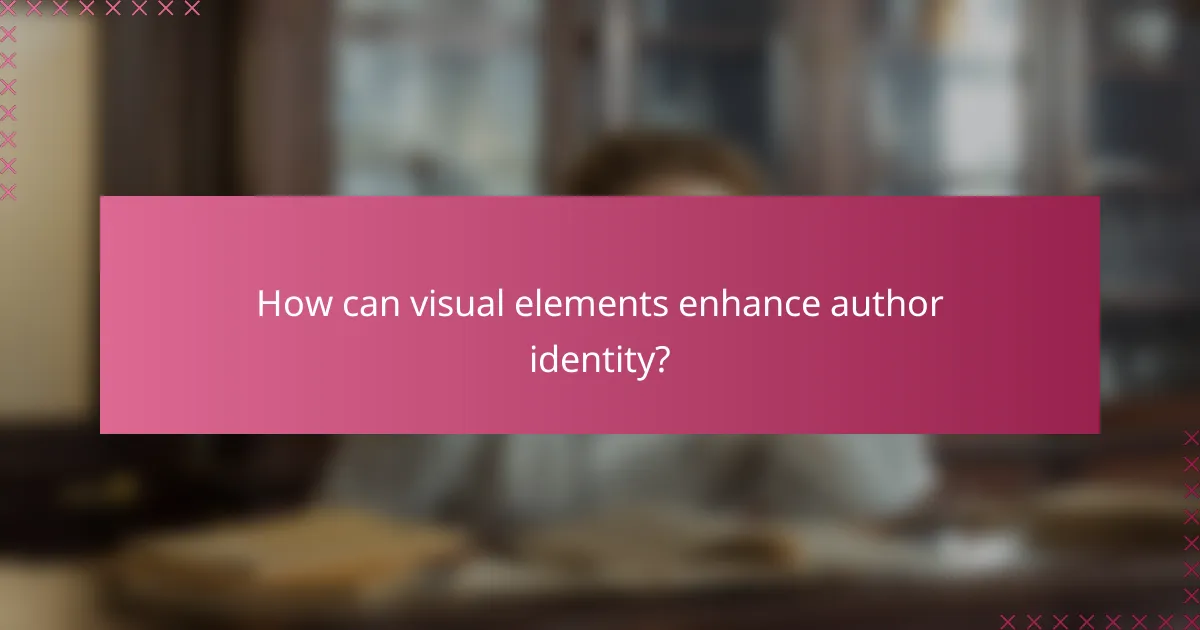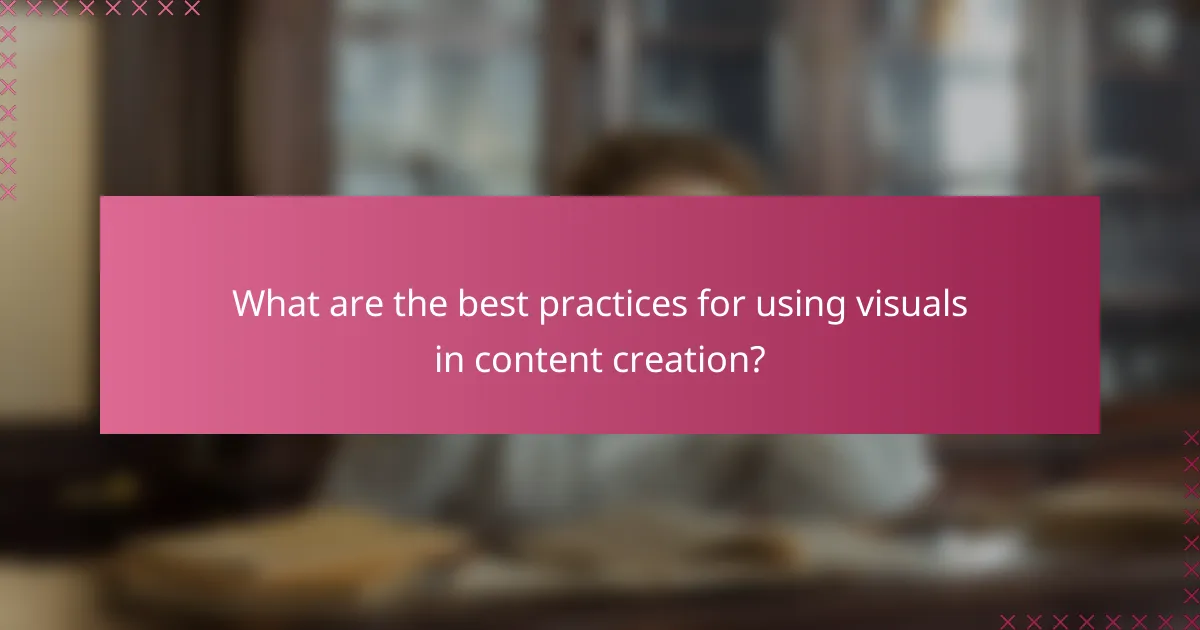Visual elements are essential for authors looking to establish a distinctive identity and engage their audience effectively. By incorporating images, logos, and cohesive color schemes, authors can convey their unique style and values, fostering a deeper connection with readers. Additionally, utilizing engaging tools like infographics and videos can enhance communication, making content more appealing and accessible.

How can visual elements enhance author identity?
Visual elements play a crucial role in establishing and enhancing an author’s identity by creating a recognizable and cohesive presence across various platforms. By effectively utilizing images, logos, and color schemes, authors can communicate their unique style and values, fostering stronger engagement with their audience.
Brand consistency through visuals
Maintaining brand consistency through visuals ensures that an author’s identity is easily recognizable across different mediums. This can be achieved by using the same color palette, typography, and imagery style in all content. For example, an author who writes about wellness might consistently use calming colors like greens and blues to reflect their brand’s focus on tranquility.
To reinforce brand consistency, authors should create a style guide that outlines their visual elements. This guide can include specifications for logo usage, font choices, and color codes, ensuring that all visual content aligns with their established identity.
Personal branding with images
Images can significantly enhance personal branding by showcasing an author’s personality and expertise. Authors can use professional headshots, lifestyle images, or action shots related to their work to create a more relatable and engaging image. For instance, a travel writer might share photos from their adventures to connect with readers on a personal level.
When selecting images, authors should consider the emotions they want to evoke and the message they wish to convey. Authentic and high-quality images can help build trust and rapport with the audience, making it essential to choose visuals that truly represent the author’s brand.
Use of logos and color schemes
Logos and color schemes are vital components of an author’s visual identity. A well-designed logo can serve as a visual shorthand for the author’s brand, making it easier for readers to identify their work. Authors should invest in professional logo design that reflects their genre and personal style, ensuring it is versatile for use across various platforms.
Color schemes should be carefully selected to evoke specific feelings and align with the author’s message. For example, a children’s book author might opt for bright, playful colors, while a business author may choose more subdued, professional tones. Consistently using these colors in all materials helps reinforce the author’s identity and makes their work more memorable.

What types of visual elements are effective for engagement?
Effective visual elements for engagement include infographics, videos, and interactive graphics. These tools enhance communication, making content more appealing and easier to understand for the audience.
Infographics for information delivery
Infographics are powerful tools for conveying complex information in a visually appealing format. They combine graphics with data to present facts, statistics, and trends in a way that is easy to digest. When creating infographics, focus on clarity and relevance, ensuring that the visuals support the key messages.
Consider using a mix of charts, icons, and concise text to maintain interest. Aim for a balance between informative content and aesthetic design, as overly cluttered infographics can confuse rather than clarify. Tools like Canva or Piktochart can help in designing effective infographics.
Videos for storytelling
Videos are an engaging medium for storytelling, allowing authors to connect emotionally with their audience. They can be used to share personal experiences, explain concepts, or showcase products in action. A well-produced video can significantly increase viewer retention and engagement rates.
When creating videos, keep them concise—typically under five minutes—to maintain viewer interest. Use high-quality visuals and sound, and include captions for accessibility. Platforms like YouTube or Vimeo can be effective for sharing videos widely.
Interactive graphics for user participation
Interactive graphics invite users to engage directly with content, enhancing their experience and understanding. These can include quizzes, polls, or clickable maps that allow users to explore information at their own pace. This level of engagement can lead to higher retention and satisfaction rates.
To create effective interactive graphics, ensure they are intuitive and user-friendly. Use clear instructions and feedback mechanisms to guide users. Tools like Adobe Animate or Tableau can facilitate the development of engaging interactive elements.

How to choose the right visuals for your audience?
Selecting the right visuals for your audience involves understanding their preferences and demographics. Effective visuals resonate with viewers, enhancing engagement and reinforcing your author identity.
Understanding audience demographics
Demographics such as age, gender, education level, and cultural background significantly influence how visuals are perceived. For instance, younger audiences may prefer vibrant colors and modern designs, while older demographics might respond better to classic styles and muted tones.
Gather demographic data through surveys, analytics, or social media insights to tailor your visuals accordingly. This information helps in creating content that speaks directly to the interests and values of your target audience.
Aligning visuals with audience preferences
Identifying audience preferences is crucial for visual selection. Consider what types of images, graphics, or videos your audience engages with most. For example, if your audience favors infographics over text-heavy content, prioritize creating visually appealing data representations.
Utilize tools like A/B testing to compare different visual styles and formats. This approach allows you to see which visuals drive higher engagement rates, helping you refine your strategy over time.
Testing visual effectiveness
Regularly testing the effectiveness of your visuals is essential for maintaining audience engagement. Use metrics such as click-through rates, time spent on page, and social shares to evaluate how well your visuals perform.
Implement feedback loops by encouraging audience input on visuals through comments or surveys. This direct feedback can guide future visual choices and ensure they align with audience expectations and preferences.

What role do social media visuals play in author engagement?
Social media visuals are crucial for enhancing author engagement by capturing attention and conveying messages quickly. Effective visuals can increase interaction rates, build a recognizable brand, and foster a deeper connection with the audience.
Visuals for social media branding
Visuals play a significant role in establishing an author’s brand identity on social media. Consistent use of colors, fonts, and imagery helps create a recognizable aesthetic that resonates with followers. For example, an author might use a specific color palette across all posts to reinforce their brand.
Incorporating personal elements, such as behind-the-scenes images or unique graphics, can further humanize the author and make their brand more relatable. This approach encourages followers to engage more deeply with the content.
Engagement metrics for visual content
Measuring engagement metrics for visual content is essential to understand its effectiveness. Key metrics include likes, shares, comments, and click-through rates. For instance, posts with images typically receive higher engagement than text-only posts, often seeing increases of 50% or more in interactions.
Tracking these metrics over time allows authors to refine their visual strategies. Authors should focus on which types of visuals generate the most engagement and adjust their content accordingly to maximize audience interaction.
Platforms for sharing visual content
Different social media platforms offer unique opportunities for sharing visual content. Instagram and Pinterest are highly visual-centric, making them ideal for authors to showcase book covers, illustrations, and promotional graphics. In contrast, Facebook and Twitter allow for a mix of visuals and text, providing a broader context for engagement.
Authors should tailor their visual content to fit the platform’s strengths. For example, using high-quality images and engaging captions on Instagram can drive more traffic to an author’s website or book sales. Understanding the nuances of each platform can significantly enhance engagement rates.

How can visual elements improve e-commerce author identity?
Visual elements play a crucial role in enhancing e-commerce author identity by creating a distinctive brand image and fostering customer engagement. Effective use of visuals helps convey the author’s personality and values, making the shopping experience more relatable and trustworthy.
Product images and descriptions
High-quality product images and well-crafted descriptions are essential for establishing a strong author identity. Clear, detailed images allow customers to visualize the product, while descriptions that reflect the author’s voice can create a connection with potential buyers. Aim for multiple angles and lifestyle shots to showcase the product in use.
Consider using a consistent style for images and descriptions to reinforce brand identity. For instance, if the author emphasizes sustainability, highlight eco-friendly materials in descriptions and use natural settings for product photography.
Visual storytelling in product marketing
Visual storytelling involves using images and graphics to narrate a brand’s story, enhancing emotional engagement with customers. This approach can include infographics, videos, or a series of images that illustrate the product’s journey from creation to delivery. Such storytelling can significantly boost brand loyalty and recognition.
To implement visual storytelling effectively, focus on the core message that aligns with the author’s identity. Use visuals that resonate with the target audience, such as behind-the-scenes content or customer experiences, to create a more immersive shopping experience.
Customer reviews with visuals
Incorporating visuals in customer reviews can significantly enhance credibility and author identity. Customers are more likely to trust reviews that include images or videos, as they provide authentic proof of product quality and satisfaction. Encourage customers to share their experiences visually, which can also serve as user-generated content for marketing.
To maximize the impact of visual reviews, consider creating a dedicated section on the e-commerce site for customer photos. This not only showcases real-life usage but also fosters a community around the brand, reinforcing the author’s identity and values.

What are the best practices for using visuals in content creation?
Effective use of visuals in content creation enhances author identity and boosts audience engagement. Key practices include maintaining consistency, optimizing for accessibility, and ensuring relevance to the content.
Consistency in visual style
Maintaining a consistent visual style across your content helps establish a recognizable brand identity. Use a uniform color palette, typography, and imagery style to create a cohesive look that resonates with your audience.
Consider creating a style guide that outlines your visual elements, including logo usage, font choices, and image guidelines. This guide will serve as a reference for anyone involved in content creation, ensuring that all visuals align with your brand’s identity.
When selecting images, aim for a similar tone and quality. For example, if you use bright, vibrant images in one piece, avoid dark or muted visuals in another. This consistency reinforces your message and enhances viewer trust.
